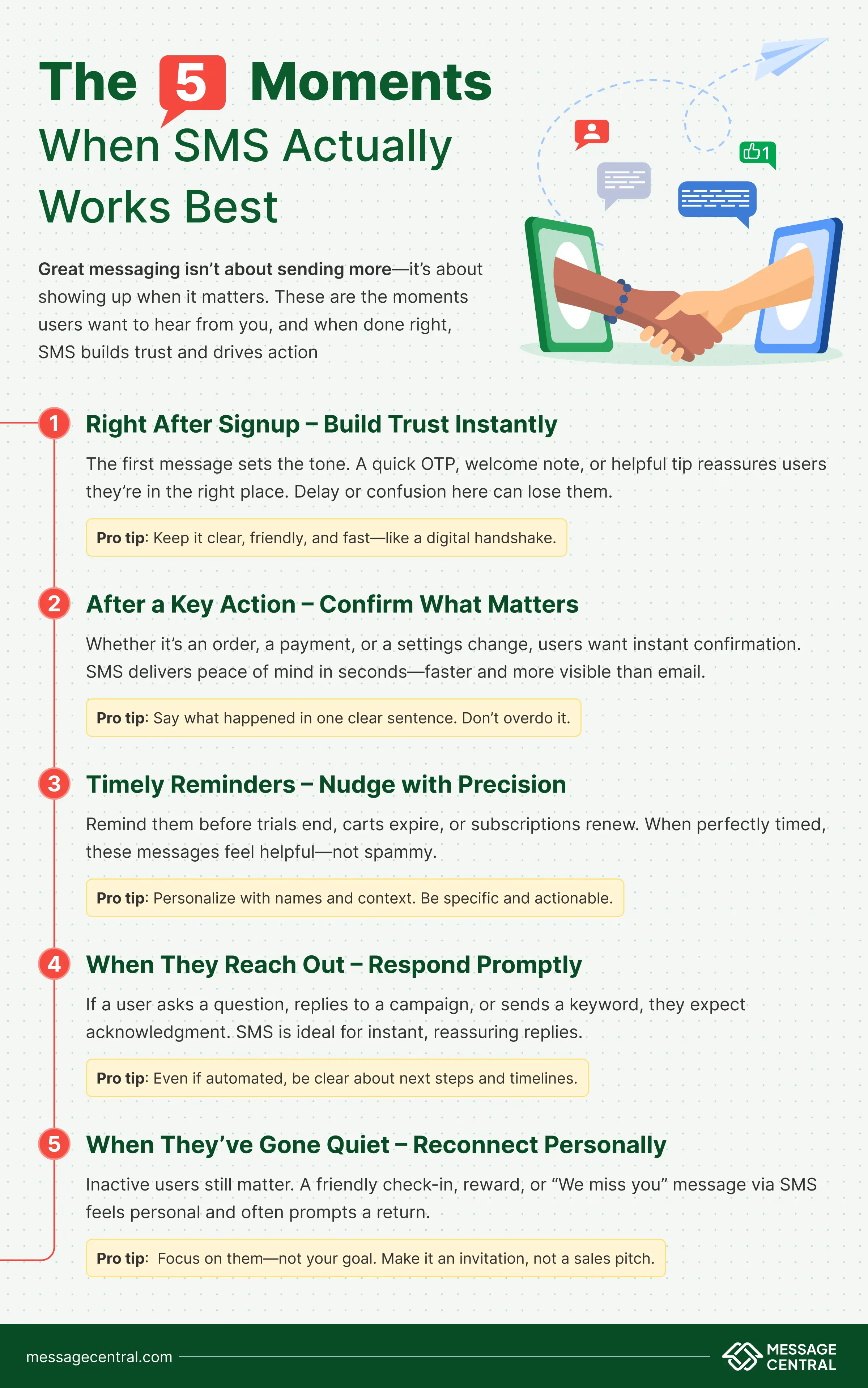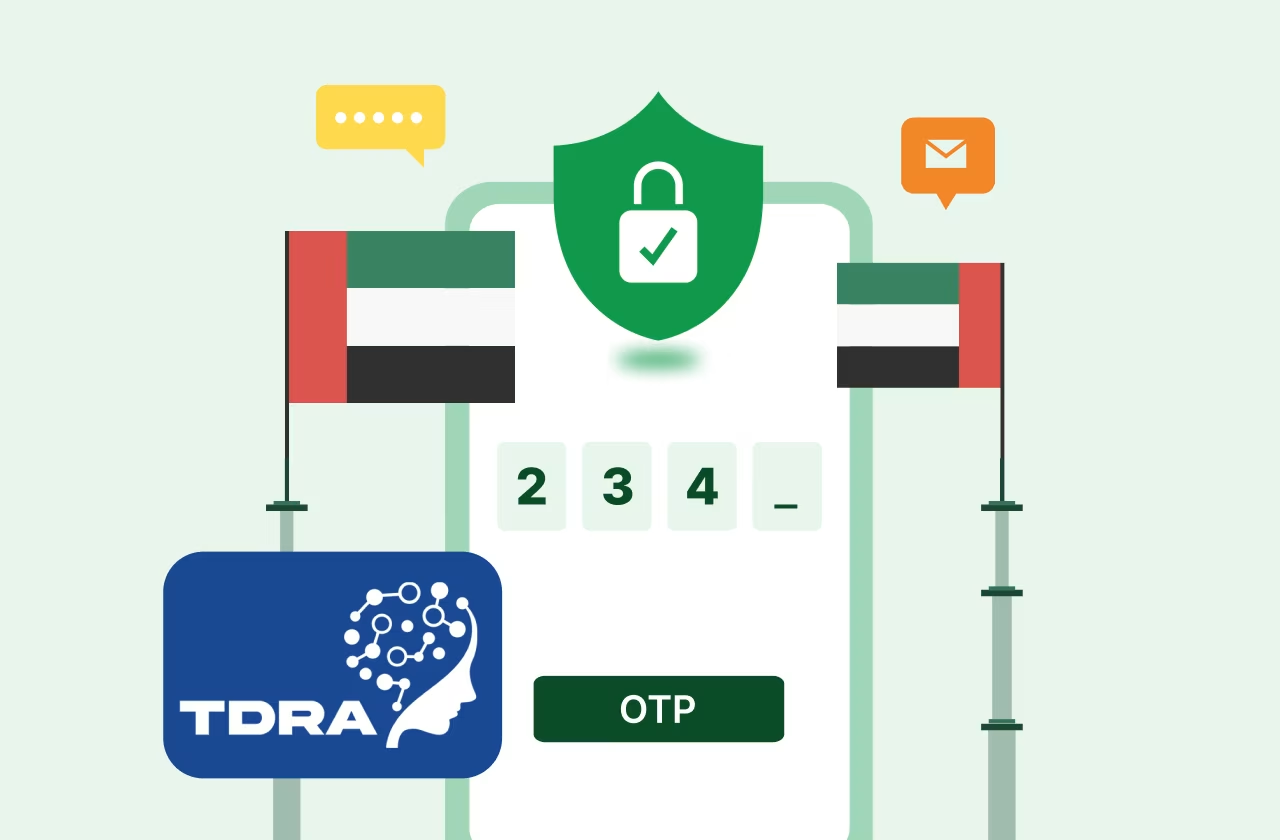Key Takeways
Introduction: Why SMS Still Works (When Done Right)
Picture this. You’re waiting in line for coffee. Just as you place your order, your phone buzzes. It’s a quick SMS: “Your order’s being prepared. ETA: 6 minutes.” You don’t open an app. You don’t tap around. You just know. And that simple message makes the whole experience smoother.
Now imagine the opposite. It’s 3:14 a.m. Your phone lights up with an SMS: “FLASH SALE ENDS TONIGHT!” The sale? Already over. Or worse, a delivery alert for a package that arrived two days ago. Annoying, right? You don’t just roll your eyes—you unsubscribe.
That’s the power and the problem with SMS. When used well, it can build trust and reduce friction in real time. But when misused, it pushes people away.
That one small difference—sending the right message at the right moment—is what separates great user experiences from forgettable ones. And it’s not about fancy features or AI-generated copy. The core of it comes down to timing, context, and intent.
SMS still holds its ground as one of the most powerful tools in a product team’s toolkit. It gets seen. It gets read. In fact, over 90 percent of texts are opened within three minutes, and most replies happen in under 90 seconds. That’s the kind of immediacy few other channels can match.
But with great power comes great responsibility. SMS is also one of the most heavily regulated communication channels across the world. Countries have strict frameworks to protect users. Messages must be correctly categorized—whether they’re promotional, transactional, or verification related. Consent is not optional. And spam? It’s a surefire way to lose users, fast.
Still, too many businesses miss the mark. They blast the same message to every user, regardless of time zones, behavior, or intent. They send promotions at odd hours or drop OTPs that arrive far too late. And when users feel disrupted or ignored, they disengage.
That’s where smarter tools like MessageNow can help. Instead of treating SMS like a megaphone, MessageNow helps you turn it into a real-time, responsive communication layer. Whether you need to deliver an OTP the second a user signs up or send a well-timed reminder before a subscription renews, MessageNow makes sure your message lands when and where it matters.
In this guide, we’ll walk through the key user moments where SMS can truly shine. You’ll learn what makes a message feel helpful instead of disruptive, and how high-performing teams use messaging strategies to drive both engagement and revenue.
The 5 Moments When SMS Actually Works
Great messaging isn't about sending more. It's about showing up when it matters. The best businesses don’t blast users at random hours or recycle the same template to everyone. They time their messages with care, aligning them with real user behavior and needs.
Here are five moments when users are not only open to hearing from you but actually expect it. Get this right, and you’re not just improving engagement—you’re building trust.
- When Someone Signs Up and You Need to Build Trust Quickly
The moment a new user joins your platform, every second counts. This is where a clear, timely message can make all the difference. A well-timed OTP, a short welcome text, or even a helpful tip lets them know your product works and that they’re in good hands. If you fumble this moment with delays or confusing wording, you risk losing them before they even get started.
Tip: Keep your message simple, specific, and friendly. Think of it as a digital handshake.
- When Something Important Just Happened
Maybe it’s an order confirmation, a payment success message, or a change to their account. These updates matter. And in high-stakes scenarios, SMS is the fastest way to give users peace of mind. Unlike email, SMS gets read almost instantly, which is exactly what you want when a user is wondering, “Did that go through?”
Tip: Don’t overcomplicate it. One line is enough if it tells them exactly what they need to know.
- When You’re Reminding Them About Something They Care About
This is where timing becomes everything. A cart reminder, a heads-up before their trial ends, or a final nudge before a subscription renews—these messages can easily feel like spam if they’re off by a few hours. But when they land at just the right moment, they feel helpful.
Tip: Personalize whenever you can. Use their name, refer to the action they took, and be clear about what comes next.
- When They Reach Out First
If a user asks for support, responds to a campaign, or sends a keyword, they’re opening the door. Don’t leave them hanging. These are the moments where responsiveness drives loyalty. Even if your reply is automated, users appreciate knowing their request was received and is being taken care of.
Tip: Let them know what to expect and when. A little clarity goes a long way in reducing friction.
- When They’ve Gone Quiet and You Want to Reconnect
Everyone has inactive users. But SMS gives you a rare chance to bring them back with a personal touch. Whether it’s a quick check-in, a loyalty reward, or a simple “We miss you,” these messages work because they feel like someone noticed. Unlike email campaigns that get buried, a friendly text feels immediate.
Tip: Keep the focus on them, not on what you want. Make the message feel like an invitation, not a pitch.

What Makes an SMS Message Actually Work?
Let’s be honest. We’ve all seen both ends of the SMS spectrum.
There’s the kind that makes you smile or feel reassured, like when your OTP arrives just as you tap “Login.” And then there’s the kind you delete without a second thought, or worse, mark as spam.
So what separates a high-performing SMS from the forgettable ones? It’s not just about clever copy. It’s about how well the message fits the moment. It’s about tone, timing, and purpose.
Let’s unpack the building blocks of a great SMS experience.
1. Clear Copy That Leaves No Room for Confusion
A user shouldn’t have to read a message twice to understand it. Especially if it's part of a critical flow like an OTP, a password reset, or a payment alert. Vague alerts or jargon-filled messages only lead to hesitation and mistrust.
Forgettable:
“Alert! Your account has activity. Click here to view.”
Better:
“Hi John, we noticed a login from a new device. If this was you, you’re all set. If not, secure your account here: app.com/secure”
Plain, conversational, and to the point. That’s the kind of SMS that builds confidence and improves engagement.
2. One CTA Is All You Need
An effective SMS should have one job. Not two, not three. Just one.
Think of it as a moment to guide the user toward a single action—whether it’s verifying their account, tracking a delivery, or upgrading their plan. If you ask them to do too much, chances are they’ll do nothing at all.
Try this simple format:
Action + Benefit + Timeframe
Example:
“Upgrade now to get unlimited access before your trial ends tonight.”
This not only boosts clarity but also improves click-through rates.
3. Use the Right Tone to Build Trust
Even a 160-character SMS can reflect your brand's personality. It can sound like a helpful friend or a cold system alert.
Compare these:
Robotic:
“Code: 957384. Do not share.”
More human:
“Hi Sara, here’s your OTP: 957384. It’s valid for 10 minutes. Need help? Visit app.com/help”
A little warmth goes a long way, especially in transactional or security-related messages. And with SMS being such a personal channel, tone matters more than most teams think.
4. Timing Isn’t Just Important—it’s Everything
You could have the most perfectly worded SMS in the world, but if it arrives too early or too late, it misses the moment.
Timing is what turns a message into a nudge, or an alert into peace of mind. And it varies depending on the use case.
Here’s a quick reference to time your SMS campaigns right:
- OTP or Verification Codes: Send immediately, within 2 to 3 seconds
- Trial Expiry Reminders: 24 hours before, and then 2 hours before expiry
- Abandoned Cart Nudges: 30 to 60 minutes after inactivity
- Welcome or Onboarding Flows: Within 5 minutes of signup
- Reactivation or Winback: 7 to 14 days after last activity
Conclusion: The Right SMS at the Right Time Changes Everything
In a world where inboxes are flooded and notifications are ignored, SMS still has an edge. It reaches users directly. It’s personal, fast, and usually read within minutes. But to truly make an impact, your SMS needs to show up at the right time, with the right message.
An OTP that arrives five minutes too late might as well have never arrived. A reminder sent after the trial ends won’t win anyone back. What separates smart businesses from everyone else is not just what they say over SMS, but when and why they say it.
This is where the real work begins. Sending timely, useful SMS messages consistently require more than guesswork or batch-and-blast campaigns. You need a system that’s flexible, fast, and deeply connected to how your product works.
MessageNow by Message Central helps you do just that. Whether you're triggering login verifications, follow-ups, or winback messages, MessageNow gives you the tools to send SMS messages that are relevant and reliable. With easy API integration and global delivery built in, it's designed for teams that want to engage users, not just ping them.
Because in the end, the right SMS at the right moment is not just another message—it’s a moment of trust. And the more of those you create, the stronger your user relationships become.










